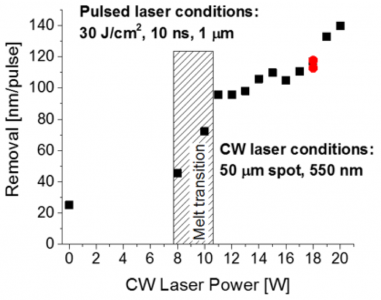Jeffrey Bude (16-ERD-016)
Executive Summary
We are developing a theoretical and experimental understanding of the mechanisms of ablation, material damage, and failure for optical materials, semiconductors, and metals. We are integrating laser material testing, advanced diagnostics, characterization, and simulation to develop a more rigorous understanding of pulsed-laser processes and provide the foundation for new defense and industrial applications, as well as new high-average-power pulsed-laser capabilities.
Project Description
Pulsed-laser material modification can lead to material and component failure in advanced laser systems or sensitive defense-related systems. Laser systems used for scientific applications and national security missions are often designed to operate under conditions of extreme optical intensity, high average power, or high flux density. This can result in degradation and damage to key optical components, limiting system performance and imposing severe constraints on operation. General modes of damage are related to how different materials absorb energy and how they respond to this energy deposition. For laser-based machining, these damage modes affect product throughput and precision, and cause collateral damage. In this research project, we will integrate laser material testing, advanced diagnostics, characterization, and simulation to develop a more rigorous theoretical and experimental understanding of pulsed-laser processes in dielectrics, semiconductors, metals, and ion-doped glasses relevant to damage, material failure, ablation physics, and pulsed-laser machining.
We expect to develop a theoretical and experimental understanding of the mechanisms of ablation, material damage, and failure for optical materials, semiconductors, and metals. General modes of damage are related to how different materials absorb energy and how they respond to this energy deposition. These same issues drive optimization and extension of laser-based material processing, and affect laser-based machining. We intend to (1) determine how material properties affect damage, (2) identify wavelength-dependent mechanisms for surface damage, (3) develop models of short-pulse (<10 ps) ablation and laser machining, (4) demonstrate methods to control ablation and damage with wavelength-dependent temporal and spatial pulse shaping, and (5) develop simulation models to capture the essential physics of these processes. This work will advance understanding of pulsed-laser material-failure mechanisms and damage limits for a general class of materials and advance the state-of-the-art in laser-based processing.
Mission Relevance
By directly addressing stockpile stewardship challenges with cost optimization and utilization of large fusion-class laser systems and by providing guidance for laser system designs with higher ultraviolet output energy or longer wavelengths, this research project supports Lawrence Livermore National Laboratory's core competency in lasers and optical science and technology. The development of materials for high-average-power systems also supports the Laboratory's core competency in advanced materials and manufacturing. Our work will provide new insights into defense-related directed-energy vulnerabilities pertaining to the DOE’s goal to strengthen key science, technology, and engineering capabilities and modernize the national security infrastructure. In the long run, this project can provide the foundation for new defense and industrial programs as well as the rationale and impetus for new high-average-power pulsed-laser programs.
FY17 Accomplishments and Results
In FY17 we have (1) studied the role of material properties on initiation and damage growth for 351-nm, 5-ns pulses in silica, sapphire, calcium fluoride, and potassium dihydrogen phosphate; (2) performed experiments and simulations to elucidate the mechanisms of hydrodynamic melt ejection using temporal pulse shaping with a combination of continuous-wave (CW) pulsed lasers, and modulation; (3) demonstrated and modeled modes of enhanced material removal; (4) performed three-dimensional simulations of silicon and aluminum ablation, including material failure; (5) extended ablation simulations to metals (i.e., aluminum); (6) performed imaging experiments with silicon picosecond-pulse ablation and laser hole drilling in aluminum; and (7) investigated combined CW and pulsed laser ablation for high-aspect-ratio hole drilling.
   






